While Vietnamese cuisine is celebrated globally for its iconic phở and bánh mì, the true breadth of Vietnam’s culinary landscape is a vibrant tapestry of flavors, textures, and aromas. Exploring Vietnam Specialty Food is not just about eating; it’s a journey into the country’s rich history, diverse culture, and the daily lives of its people. From bustling street corners to hidden local eateries, every dish tells a story, making the culinary scene an essential part of any Vietnamese adventure.
Vietnamese cooks masterfully utilize the abundant local produce and unique regional ingredients. Northern cuisine is often appreciated for its subtle balance, while the central region, particularly Hue, is known for its bold spices and elaborate presentations, reflecting its imperial past. In the South, there’s a preference for sweetness and the generous use of fresh herbs. No matter which part of the country you explore, savoring the Vietnam Specialty Food is a guaranteed highlight.
Phở: The Soulful Noodle Soup
Phở is arguably the most recognized Vietnam Specialty Food, with the word itself referring to the flat rice noodles central to the dish. This comforting soup features tender slices of beef (often medium-rare) or boiled chicken swimming in a deeply savory beef bone broth.
The two most famous versions are phở Hanoi from the North, known for its clear, elegant broth traditionally garnished only with a squeeze of lime and bird’s eye chili slices, and phở Nam from the South, which typically has a slightly cloudier broth and is served with a generous plate of fresh herbs like basil, mint, and bean sprouts.
 vietnamese pho
vietnamese pho
The heart of a great bowl of phở is its broth, often simmered for hours with star anise, cloves, cinnamon, and ginger, imparting a subtle sweetness and complex aroma. This ubiquitous dish is enjoyed throughout the day but is a particularly popular and energizing breakfast for locals. It’s a quintessential Vietnam Specialty Food experience.
Try it: Pho Thin, 13 Lo Duc, Hai Ba Trung District in Hanoi or Pho Hoa, 260C Pasteur Street, District 3 in Ho Chi Minh City.
Bánh Mì: Vietnam’s Beloved Sandwich
The baguette, a legacy of French colonial rule, was ingeniously adapted by Vietnamese cooks to create the bánh mì, a distinctive Vietnam Specialty Food. Crispy on the outside and soft and airy inside, the bread is typically spread with pâté and margarine.
It’s then generously filled with an array of delicious ingredients, including various cold cuts or grilled meats, pickled carrots and daikon, fresh cucumber slices, cilantro, and sometimes pork floss.
 Banh mi by Aaron Joel Santos Top 21 Dishes
Banh mi by Aaron Joel Santos Top 21 Dishes
Each bite offers a delightful contrast: the satisfying crunch of the crust giving way to the soft interior and the explosion of savory, tangy, and fresh flavors from the fillings. Bánh mì is a perfect example of culinary fusion becoming a unique Vietnam Specialty Food.
Try it: Banh My Phuong, 2B Phan Chau Trinh, Hoi An.
Cơm Tấm: Humble Broken Rice
Originating from the days when farmers would cook the fractured rice grains that couldn’t be sold, cơm tấm (broken rice) has transformed into a beloved staple for the working class and a notable Vietnam Specialty Food. Despite its humble beginnings, presentations can be quite elaborate and flavorful.
The most popular preparation is cơm tấm sườn nướng ốp la, featuring broken rice topped with a perfectly grilled, caramelized pork chop and a fried egg (ốp la). The dish is then drizzled with nước chấm (a fish sauce-based dressing combining chili, sugar, and lime) and green onion oil.
 Christian Berg Top 21 Dishes Vietnamese Food
Christian Berg Top 21 Dishes Vietnamese Food
Planning Your travel to las vegas nevada
Plan Your Perfect Mackinac Island Vacation – Your Essential Guide
Exploring Cities In Las Vegas – Uncovering Nearby Wonders 2025
Accompaniments often include pickled shredded carrots and daikon, fresh tomato and cucumber slices, and a sprinkle of crushed fried pork rinds and shallots for added texture and flavor. Cơm tấm represents resilience and creativity in Vietnam Specialty Food.
Try it: A family-operated stall on 260 Vo Van Tan, District 3, Ho Chi Minh City.
Bún Bò Huế: The Imperial City’s Spicy Noodle Soup
From the former imperial capital, bún bò huế is a powerful and flavorful Vietnam Specialty Food, showcasing both visual appeal and intense taste. The broth’s characteristic reddish hue hints at its depth, achieved by simmering beef bones and a significant amount of lemongrass for hours.
Lemongrass lends a unique citrusy note, while chili and shrimp paste add spice and depth. The soup is typically served with thick rice vermicelli noodles, tender beef shanks, and sometimes pork knuckles.
 Bun Bo Hue by Aaron Joel Santos Top 21 Dishes
Bun Bo Hue by Aaron Joel Santos Top 21 Dishes
A common addition is chả lụa, a type of Vietnamese pork sausage with a firm, smooth texture. Flash-boiled vegetables are often served on the side to add freshness and crunch. This dish is a bold and unforgettable Vietnam Specialty Food experience.
Try it: Quan Bun Bo Hue, 19 Ly Thuong Kiet Street, Hue.
Cao Lầu: Hoi An’s Unique Fusion Noodles
Exclusively found in the ancient trading port of Hoi An, cao lầu is a truly regional Vietnam Specialty Food. Its existence is intertwined with the town’s history as a melting pot of cultures, reflected in the dish’s blend of Japanese (udon-like noodles), Chinese (char siu pork), and Vietnamese influences.
The thick, chewy cao lầu noodles are topped with slices of succulent Chinese barbecued pork. A small amount of savory broth is added, distinct from typical noodle soups, before being garnished with fresh local herbs, bean sprouts, and crispy pork cracklings or croutons.
 Cao Lau by Aaron Joel Santos Top 21 Dishes
Cao Lau by Aaron Joel Santos Top 21 Dishes
Local legend claims that authentic cao lầu noodles must be made using water from the ancient Ba Le well in Hoi An and ash from local trees, giving them their unique texture and flavor. This makes it a uniquely place-bound Vietnam Specialty Food.
Try it: Thanh Cao Lau, 24 Thai Phien St, Hoi An.
Cơm Gà: Hoi An Chicken Rice
Simple yet exquisite, cơm gà (chicken rice) is another Vietnam Specialty Food deeply associated with Hoi An. This dish elevates the familiar combination of chicken and rice using fresh, high-quality ingredients sourced from the surrounding countryside.
Tender boiled or poached chicken is shredded and mixed with a flavorful dressing, often including fish sauce, lime juice, and onions. This succulent chicken is served alongside turmeric-infused rice, which gets its golden hue and fragrance from cooking with chicken broth and turmeric.
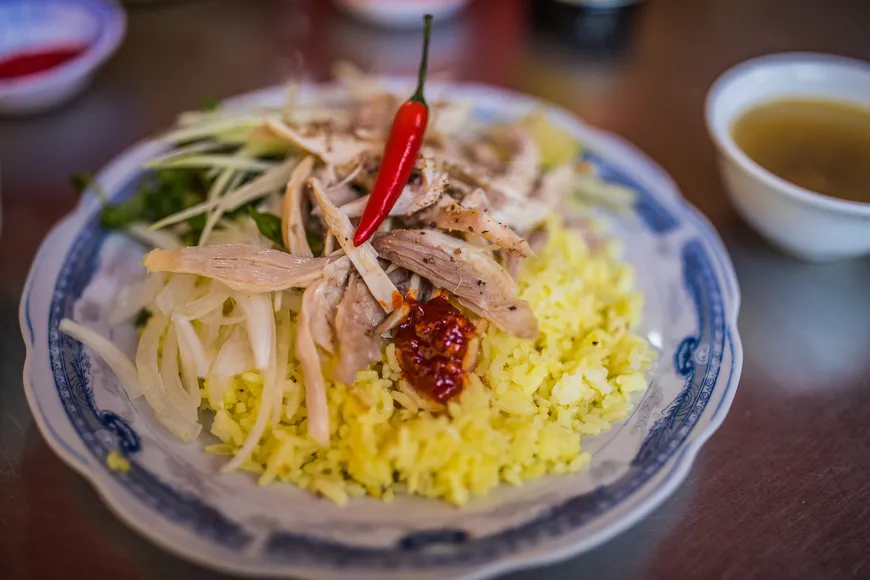 must try dishes com ga
must try dishes com ga
The dish is typically accompanied by pickled shallots, radish, and a variety of fresh herbs like Vietnamese coriander and hot mint, adding layers of freshness and zest. After exploring Hoi An’s charming streets, a plate of cơm gà is the perfect comforting Vietnam Specialty Food.
Try it: Com Ga Hien, 539 Hai Ba Trung St, Hoi An.
Mì Quảng: The Noodle Dish That’s Not Quite Soup
Mì quảng, from the Quang Nam province in Central Vietnam, is a fascinating Vietnam Specialty Food that blurs the lines between soup and salad. Despite its elegant presentation, it’s a popular and accessible street food.
The most striking feature is the wide, flat yellow noodles, colored by turmeric added to the dough or broth. Only a small amount of rich, turmeric-infused broth (often flavored with pork or chicken and sometimes thickened with peanut oil) is ladled over the noodles.
 best vietnamese dishes
best vietnamese dishes
Toppings vary widely but commonly include shrimp, chicken, pork belly, or even snakehead fish. Mì quảng is served with an essential platter of fresh herbs, sliced banana blossoms, and toasted sesame rice crackers (bánh tráng me), which are broken and mixed into the bowl, adding crunch. This vibrant dish is a true Vietnam Specialty Food experience.
Try it: Quan Mi Quang Ba Mua, 95 Nguyen Tri Phuong, Chinh Gian, Thanh Khe, Da Nang.
Bánh Xèo: The Sizzling Crepe
Bánh xèo, meaning “sizzling cake,” is a popular savory crepe found throughout South and Central Vietnam, originating from the Mekong Delta. The name comes from the loud sizzling sound the rice flour and coconut milk batter makes when it hits the hot, oiled pan.
This Vietnam Specialty Food is visually and audibly appealing. The thin batter, often colored yellow with turmeric, is swirled to cover the pan, and fillings like sliced boiled pork, minced pork, shrimp, and bean sprouts are added to one half before it’s folded over like a giant taco or crepe.
 Christian Berg Top 21 Dishes Vietnamese Food
Christian Berg Top 21 Dishes Vietnamese Food
Bánh xèo is best enjoyed fresh off the skillet when its edges are crispy and golden. It’s typically eaten by tearing off a piece, wrapping it in lettuce or rice paper with a variety of fresh herbs, and dipping it in a tangy fish sauce-based dipping sauce. This interactive dish is a fun Vietnam Specialty Food to share.
Try it: Banh Xeo 46A, 46A D Dinh Cong Trang, District 3, Ho Chi Minh City.
Bún Chả: Hanoi’s Iconic Grilled Pork with Noodles
Bún chả gained international fame when President Obama shared a meal with Anthony Bourdain, but it has long been a beloved Vietnam Specialty Food in Hanoi’s Old Quarter. The irresistible aroma of pork grilling over charcoal is a familiar scent around lunchtime in the capital.
This classic Northern dish consists of three main components: cold rice vermicelli noodles (bún); grilled seasoned pork patties (chả) and sometimes slices of grilled pork belly; and a dipping broth (often warm) made from fish sauce, sugar, vinegar, and water, containing pickled green papaya or carrots.
 Bun Cha by Aaron Joel Santos
Bun Cha by Aaron Joel Santos
Diners typically take a portion of noodles and herbs and dip them into the flavorful broth along with the grilled pork. It’s a simple yet incredibly satisfying combination of textures and flavors that makes bún chả a quintessential Hanoi Vietnam Specialty Food.
Try it: Bun Cha Huong Lien (also known as Bun Cha Obama), 24 Le Van Huu, Phan Dinh Ho, Hai Ba Trung, Hanoi.
Xôi: Versatile Sticky Rice
Xôi, Vietnamese sticky rice, is a ubiquitous Vietnam Specialty Food, offering a hearty and inexpensive meal or snack. Unlike some regional variations, Vietnamese sticky rice can be either savory (xôi mặn) or sweet (xôi ngọt), catering to diverse tastes and occasions.
Savory xôi mặn is a popular breakfast item, often topped with ingredients like fried shallots, pork floss, Vietnamese sausage, or even grilled chicken.
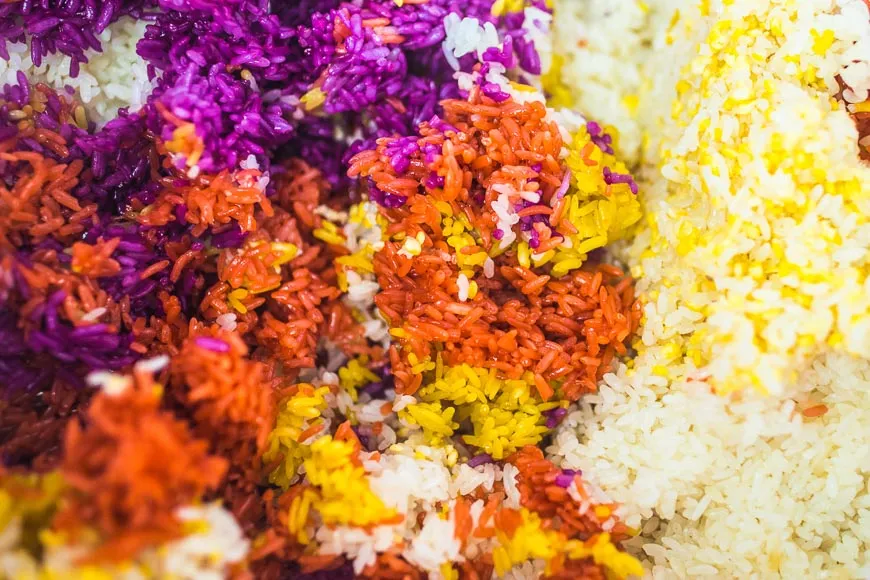 top Vietnamese dishes
top Vietnamese dishes
Sweet xôi ngọt comes in numerous varieties, often flavored and colored with natural extracts like pandan (green), gac fruit (red-orange), black beans (purple), or mung beans (yellow). Xôi ngũ sắc, the five-colored sticky rice, is a visually stunning version used in ceremonial contexts. Xôi demonstrates the versatility of rice as a Vietnam Specialty Food.
Try it: Xoi Yen, 35B Nguyen Huu Huan, Ly Thai To, Hoan Kiem, Hanoi.
Bánh Bèo: Delicate Steamed Rice Cakes
Bánh bèo are charming, bite-sized steamed rice cakes, often considered a light snack or appetizer, particularly associated with Hue in Central Vietnam. Served in small saucer-like molds, these delicate, slightly chewy disks are a delightful Vietnam Specialty Food.
Each cake is typically topped with a dollop of creamy mung bean paste and sprinkled with savory ground toasted shrimp. For added texture and flavor, crispy fried pork fat (tép mỡ) or croutons might be added.
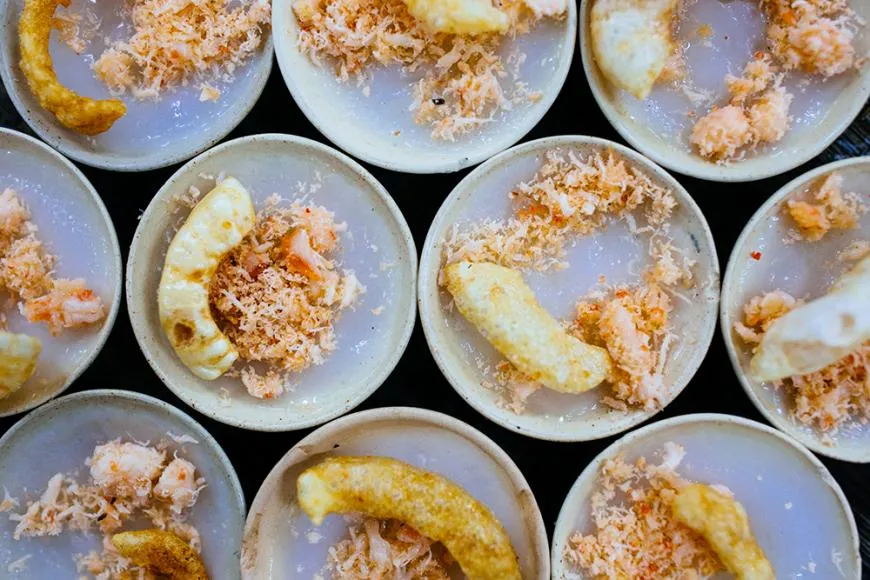 Banh Beo by Aaron Joel Santos Top 21 Dishes
Banh Beo by Aaron Joel Santos Top 21 Dishes
A well-made bánh bèo will have a slight dimple in the center. They are traditionally eaten by drizzling nước chấm (the classic dipping sauce) directly onto the cakes before lifting them out of the mold with a small spoon. These little cakes are a taste of Hue’s refined Vietnam Specialty Food culture.
Try it: Quan Hanh, 11 Pho Duc Chinh (South Bank), Hue.
Bún Riêu: Tangy Crab Noodle Soup
Bún riêu is a fragrant and flavorful Vietnam Specialty Food, known for its unique blend of crab and tomato. This hearty soup features slippery rice vermicelli noodles (bún) in a broth based on pounded crab shells, lending it a distinctive depth.
The broth is brightened by stewed tomatoes, which contribute acidity and a beautiful reddish color. Floating in the soup are fluffy clusters made from a mixture of minced crab meat, ground pork, and egg, creating a delightful texture contrast.
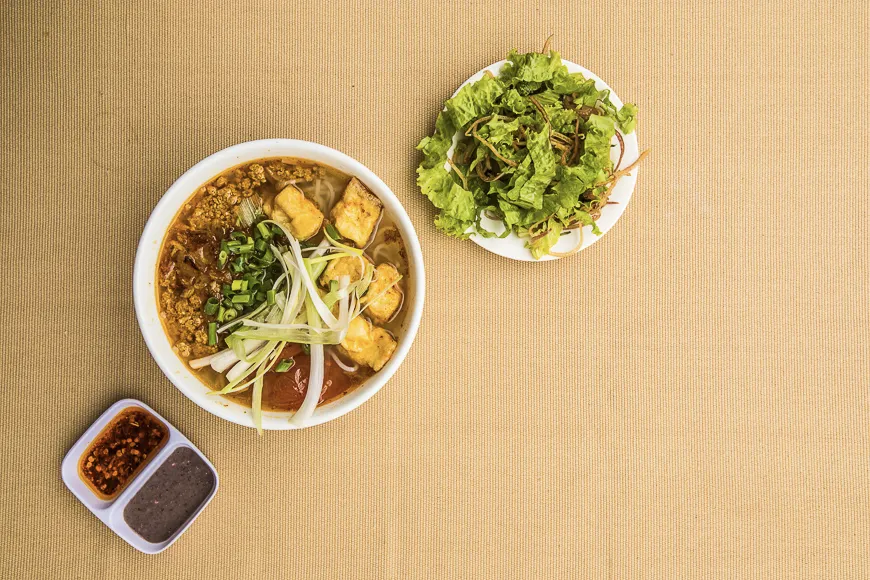 Bun Rieu by Christian Berg Top 21 Dishes
Bun Rieu by Christian Berg Top 21 Dishes
Blocks of fried tofu are also common additions. Bún riêu is served with a plate of accompanying herbs and vegetables like shredded morning glory, bean sprouts, and perilla leaves, allowing diners to customize their bowl. The complex tangy and savory profile makes it a standout Vietnam Specialty Food.
Try it: Bún Riêu Cua Thanh Hồng, 42 Hòa Mã, Ngô Thì Nhậm, Hai Bà Trưng, Hanoi.
Gỏi Cuốn: Fresh Spring Rolls
Gỏi cuốn, or fresh spring rolls, are a popular and refreshing Vietnam Specialty Food, especially appreciated for their lightness and abundance of fresh ingredients. Wrapped in softened rice paper sheets, the semi-transparent rolls reveal the vibrant contents within.
Typically filled with a combination of fresh leafy greens, herbs like mint and coriander, rice vermicelli noodles, and a protein such as sliced pork tenderloin, shrimp, or sometimes chicken. A stalk of garlic chive often pokes out from the end.
 Goi Cuon by Christian Berg Top 21 Dishes
Goi Cuon by Christian Berg Top 21 Dishes
Unlike fried spring rolls, gỏi cuốn are served at room temperature and are meant to be dipped. Common dipping sauces include a rich, peanut-based hoisin sauce or the classic nước chấm. Their freshness and clean flavors make them a healthy and delicious Vietnam Specialty Food option.
Try it: Quan An Ngon, 18 Phan Boi Chau, Hoan Kiem, Hanoi.
Bánh Căn: South-Central Mini Pancakes
Bánh căn are delightful bite-sized savory pancakes, a beloved Vietnam Specialty Food originating from the south-central coastal region. Cooked in special earthenware molds heated over charcoal, they offer a satisfying crispness.
The batter is typically made from rice flour and green onions. Traditionally, a quail egg is cracked into each mold as it cooks.
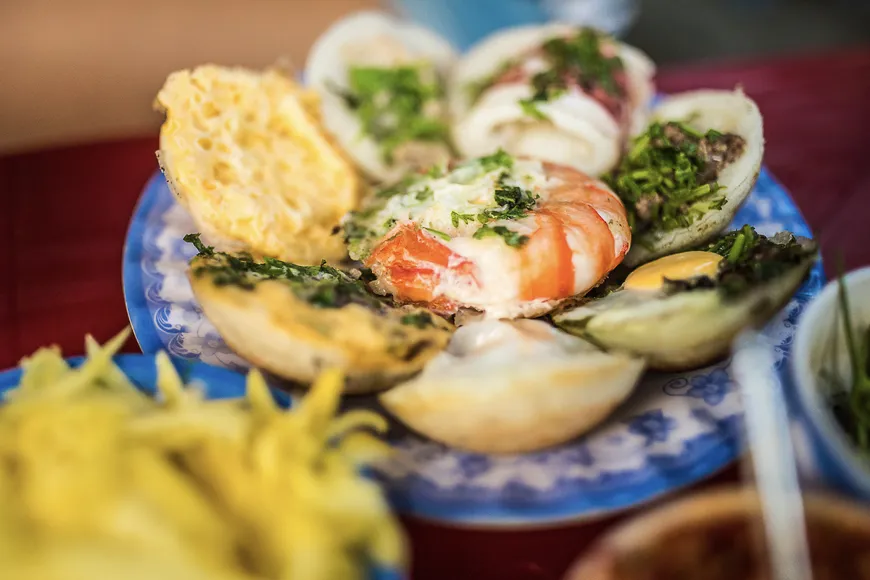 Banh Cam by Christian Berg Top 21 Dishes
Banh Cam by Christian Berg Top 21 Dishes
While plain versions exist, toppings like shrimp or minced pork are common additions today. Bánh căn is served with a dipping broth, often containing green onions and sometimes meatballs, and a side of fresh vegetables and herbs. Enjoying these warm, crispy pancakes is a true taste of regional Vietnam Specialty Food.
Try it: Phan Rang, 106 Trương Định, Phường 9, Quận 3, Ho Chi Minh City.
Hủ Tiếu Nam Vang: Southern Noodle Staple
Hủ tiếu is a standard street food noodle dish in Southern Vietnam, similar to Cambodia’s kuy teav and Thailand’s guay tiew. It’s a versatile Vietnam Specialty Food that can be served either in broth (nước) or dry (khô), with the sauce coating the noodles.
The most definitive version is Hủ Tiếu Nam Vang, believed to have Cambodian roots (“Nam Vang” being the Vietnamese name for Phnom Penh). The broth is usually made from pork bones, resulting in a clear, slightly sweet soup.
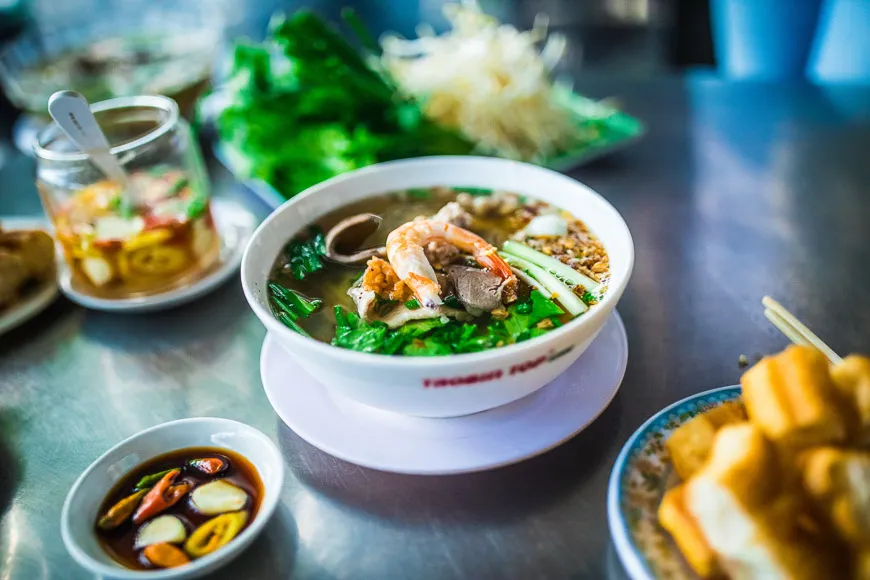 best dishes to taste Vietnam
best dishes to taste Vietnam
Typical toppings include sliced pork, boiled liver, shrimp, a quail egg, and sometimes minced pork or seafood. Some vendors might add congealed pork blood cubes, though you can request them omitted. The slight sweetness, often from rock sugar, and peppery notes define this Southern Vietnam Specialty Food.
Try it: Hu Tieu Co Huong, 152/7/2 Ly Chinh Thang, Ward 7, District 3, Ho Chi Minh City.
Chả Cá: Hanoi’s Fish with Dill and Turmeric
Chả cá is a unique Vietnam Specialty Food from Hanoi, renowned for its vibrant flavors and aromatic presentation. Chunks of flaky white fish (often hemibagrus or other local fish) are marinated in turmeric, galangal, and shrimp paste before being pan-fried.
The dish is brought to your table with the fish sizzling in a pan over a burner. Generous amounts of fresh dill and green onions are added to the hot pan and quickly cooked alongside the fish.
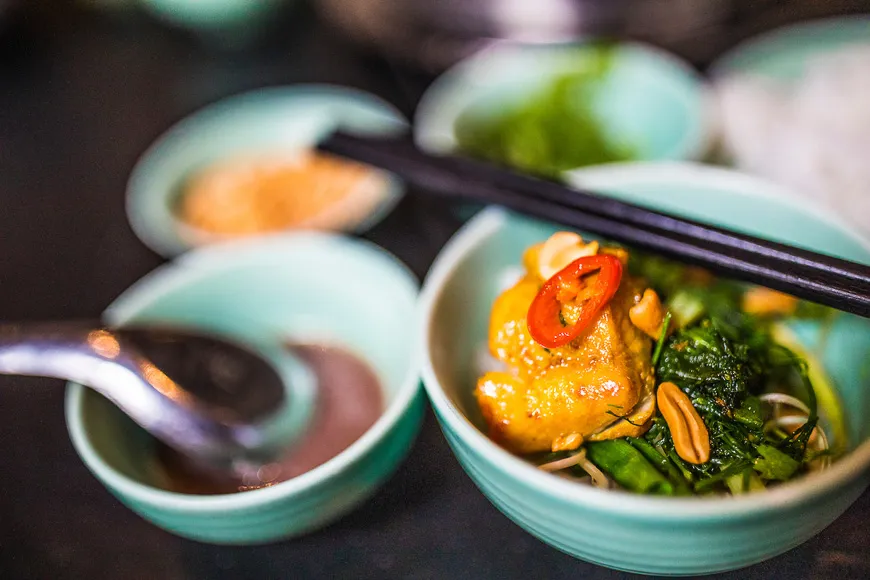 Cha Ca La Vong Top 21 Dishes
Cha Ca La Vong Top 21 Dishes
Chả cá is typically served with rice vermicelli noodles (bún), roasted peanuts, and a dipping sauce made from mắm tôm (fermented shrimp paste), which is pungent but essential to the authentic experience. The combination of rich fish, earthy turmeric, and fresh herbs creates a distinct Northern Vietnam Specialty Food.
Try it: Cha Ca Thang Long Restaurant, 19-21-31 Duong Thanh, Hoan Kiem, Hanoi.
Nộm Hoa Chuối: Refreshing Banana Flower Salad
Nộm hoa chuối, or banana flower salad, is a refreshing and visually appealing Vietnam Specialty Food, often served as a light appetizer or side dish. It’s a vibrant mix of textures and flavors centered around finely shredded banana blossoms.
The shredded banana flower is tossed with other ingredients that can vary seasonally, including pickled carrots, cabbage, lotus root, and sometimes julienned green mango or papaya.
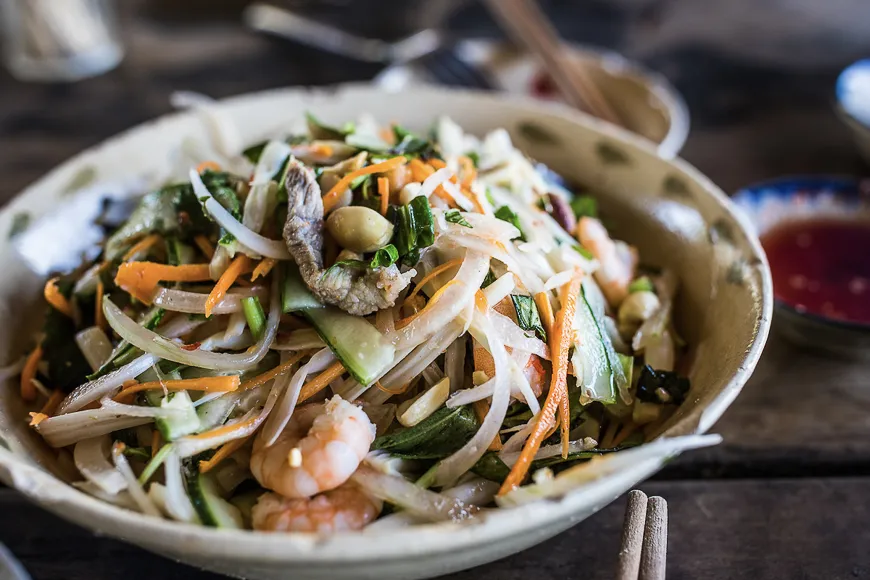 Nom Hoa Chuoi by Christian Berg Top 21 Dishes
Nom Hoa Chuoi by Christian Berg Top 21 Dishes
Protein like shredded chicken, beef, or shrimp can be added, but it’s also commonly served as a vegetarian dish. The salad is dressed with a tangy nước chấm based sauce and garnished with roasted peanuts and fresh herbs like coriander and mint. A squeeze of lime enhances its bright, zesty profile, making it a light and healthy Vietnam Specialty Food.
Try it: Mountain Retreat, 36 Le Loi, Ben Nghe, District 1, Ho Chi Minh City.
Bánh Cuốn: Delicate Steamed Rice Rolls
Bánh cuốn are delicate steamed rice rolls, a popular light meal or breakfast Vietnam Specialty Food, particularly favored in Northern Vietnam. Thin sheets of steamed rice batter are carefully spread and then filled.
The most common filling is a savory mixture of seasoned minced pork and finely chopped wood-ear mushrooms. The filled sheets are gently rolled or folded and typically cut into smaller pieces.
 Banh Cuon by Aaron Joel Santos Top 21 Dishes
Banh Cuon by Aaron Joel Santos Top 21 Dishes
Bánh cuốn is always served fresh-to-order and topped with crispy fried shallots for crunch and aroma. It’s accompanied by a side bowl of diluted nước chấm dipping sauce, often with a few slices of Vietnamese pork sausage (chả lụa). Fresh herbs can be added to the dipping sauce or alongside the rolls. These light, savory rolls are a delightful Vietnam Specialty Food experience.
Try it: Bánh Cuốn 101 Bà Triệu, 147 Triệu Việt Vương, Hai Bà Trưng District, Hanoi.
Bún Chả Cá: Fish Cake Noodle Soup
Bún chả cá, or fish cake noodle soup, is a Vietnam Specialty Food that varies significantly depending on the region. Despite local twists, the core components remain rice vermicelli noodles (bún) and fish cakes (chả cá).
One notable variation is bún chả cá Nha Trang, from the central coastal city. This version often features a light, slightly sour broth base, incorporating tomatoes.
 Bun cha sua by Christian Berg Top 21 Dishes
Bun cha sua by Christian Berg Top 21 Dishes
In addition to standard fish cakes, it often includes bouncy squid cakes (chả mực), dill, and fried green onions. Served with a side of fresh herbs and vegetables and a squeeze of lime, it’s a refreshing take on noodle soup. Trying regional variations of bún chả cá highlights the diversity within Vietnam Specialty Food.
Try it: Bún Cá Mịn 170 Bạch Đằng, Tân Lập, Nha Trang.
Bún Bò Cuốn Lá Lốt: Beef Wrapped in Betel Leaves
Bún bò cuốn lá lốt is a flavorful Vietnam Specialty Food particularly popular in the South. It features seasoned minced beef mixed with garlic and shallots, then rolled tightly inside wild betel leaves (lá lốt).
These small, cigar-like rolls are then grilled over charcoal until the betel leaves are slightly charred and fragrant, and the beef is cooked through and juicy. The grilling process infuses the beef with a distinct peppery aroma from the lá lốt leaves.
 Bun cuon la lot by Christian Berg Top 21 Dishes
Bun cuon la lot by Christian Berg Top 21 Dishes
Bò lá lốt can be enjoyed on its own, with rice vermicelli noodles (bún), or wrapped in rice paper with fresh herbs and vegetables. They are typically dipped in nước chấm, sometimes with added crushed peanuts or fermented fish paste (mắm nêm) for a stronger flavor. This savory grilled treat is a must-try Vietnam Specialty Food for meat lovers.
Try it: Cô Liêng, 321 Võ Văn Tần, District 3, Ho Chi Minh City.
Chè: Sweet Soups and Puddings
Chè encompasses a wide variety of traditional Vietnamese sweet beverages, soups, and puddings, served either hot or cold. This category represents a delightful and diverse Vietnam Specialty Food experience centered around desserts and sweet snacks.
Cold chè is especially popular in the South, often featuring a mix of jellied ingredients, legumes (like beans and mung beans), seeds (like lotus seeds), tropical fruits (banana, mango, longan), and sometimes tapioca pearls, all doused in rich coconut cream and served over crushed ice.
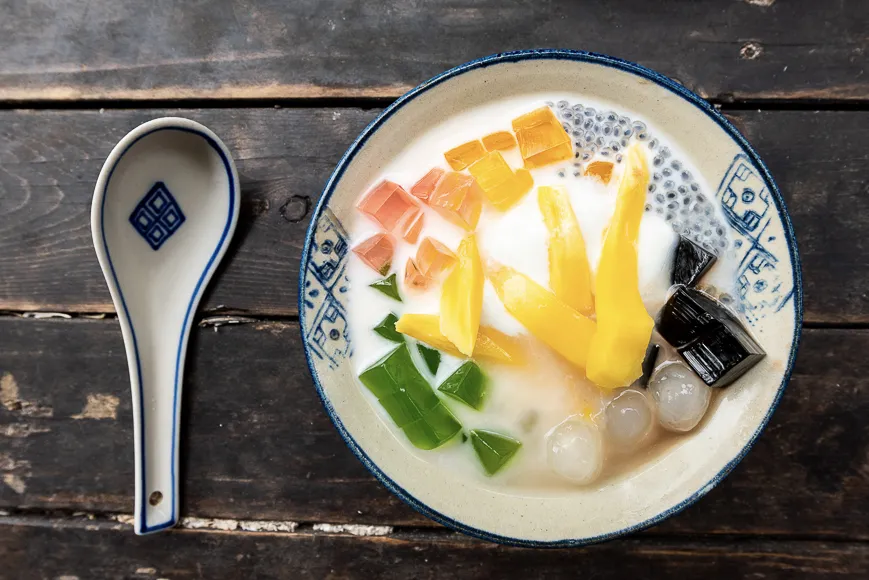 Che by Jason Zullo Top 21 Dishes
Che by Jason Zullo Top 21 Dishes
Texture is key in chè, with combinations of soft, chewy, crunchy, and smooth components in one bowl. Chè ba màu, or three-colored chè, is a famous layered dessert with red beans, yellow mung bean paste, and green pandan jelly, topped with ice and coconut milk – a visually stunning and tasty Vietnam Specialty Food dessert.
Try it: Che 95, 95 Hang Bac, Hoan Kiem, Hanoi.
Frequently Asked Questions About Vietnam Specialty Food
Q: Is Vietnam Specialty Food spicy?
A: Vietnamese cuisine utilizes chili, but spice levels vary greatly by region and dish. Central Vietnamese food (like Bún Bò Huế) tends to be spicier, while Northern food is generally milder. Many dishes allow you to add chili to your personal taste.
Q: Is it safe to eat Vietnam Specialty Food from street vendors?
A: Generally, yes. Many of the best and most authentic Vietnam Specialty Food dishes are found at street stalls. Look for vendors with high turnover, where food is cooked fresh in front of you, and locals are eating. Use your judgment regarding cleanliness.
Q: What are the key ingredients in many Vietnam Specialty Food dishes?
A: Rice and rice noodles are staples. Fish sauce (nước mắm) is fundamental for seasoning and dipping sauces. Fresh herbs (cilantro, mint, basil, perilla), lemongrass, ginger, garlic, and chilies are widely used. Coconut milk and sugar are also common, especially in the South.
Q: What’s the difference between Northern and Southern Vietnamese food?
A: Northern food is often seen as more balanced and subtle in flavor, focusing on the natural taste of ingredients. Central food is known for being spicier and more colorful, with elaborate preparations. Southern food tends to be sweeter, with more extensive use of herbs and coconut milk, reflecting the region’s abundance.
Exploring Vietnam Specialty Food is an unforgettable part of traveling through this captivating country. Each dish offers a window into local life, history, and culture, providing experiences that nourish both the body and the soul.
